Ever wanted to grow your own food and garden on a budget? Here’s what you need to know!
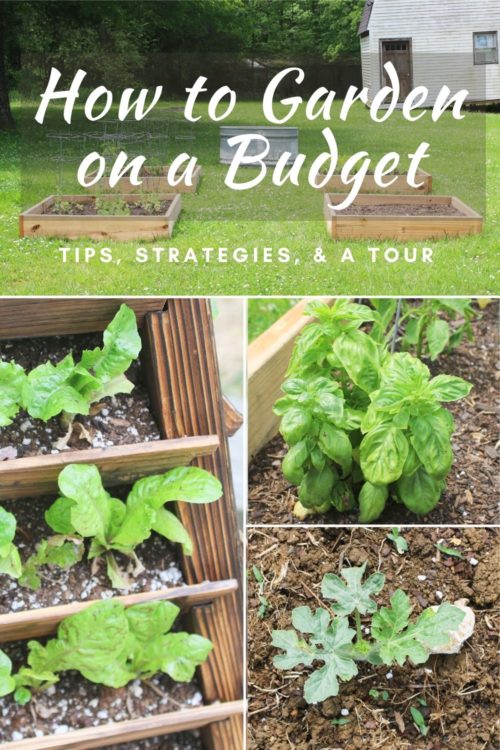
This post may contain affiliate links. Read my disclosure policy here.
This year, we moved from our tiny, fixer-upper townhouse, to a tiny, fixer-upper farmhouse on 4.5 acres. We left behind my beloved square-foot garden and had to start from scratch this spring. However, since we’re currently cash-flowing major repairs on the 80 year-old farmhouse, we had to build the garden on a budget.
After 10+ years of growing my own food in one way or another, I was ready to go big. This was one reason we moved to the farmhouse – so I could grow more of our food. But debt-free living requires us to get creative.
Thank God, because I love how our garden turned out.
How to Start a Garden on a Budget
If you’re just starting your garden, and you’re on a budget, here’s the best advice you’ll hear: start small.
It takes time to develop your gardening skills (how do I grow okra?), get to know your space (how much sun does this part of the yard get? Do cucumbers like this much sun?), and learn what you can handle (no one wants to weed in July).
Thank God for budgets.
When we start small, we develop those skills and we avoid wasting money by making big mistakes. Any mistakes you make with a small garden are small in all the ways, and you’ll do better next year.
I’ve been growing my own food since before I had kids. It started with some seeds in a jar with a sprouting lid.
This year, we have about 600 square feet of garden – over half the size of our house.
Start small.
Here’s a handy video about gardening on a budget!
How to Garden on a Budget
How do I start a low budget garden?
After we decided to build a garden, we did a few things to make sure it would succeed.
1. Ask local gardeners what works for them
First, we talked to our neighbor, who grows a big garden every year, and discovered what it was like to garden in this area. What grew easily for him, what kind of trouble did he have with pests and critters? Did he need a fence?
If you are in the United States, you can learn more about you area by calling your local cooperative extension services. Go here to find the one in your State.
2. Find a sunny location
Next, we watched the sunlight in our yard. Our house is surrounded by trees, which will feel great during the Summer months, but this means that our garden needs to be further away from the house in order to get adequate sunlight.
3. Decide what kind of garden will work for you.
Lastly, we had to decide what kind of garden we wanted to build. I’ve done all kinds, including container gardens, pallet gardens, and square-foot gardens. In general, I prefer raised beds becasue they are very low-maintenance and can have very high yields. Plus, they don’t require soil testing tilling. Every spring, I stir in a little compost and start planting. That’s it!
(Read or watch the video all about our budget-friendly square-foot garden here!)
This year, because we are on a budget, I need to balance what we have available (free or cheap) and what I can commit to caring for during our growing season.
We have 4 garden spaces this year:
1. A tilled 22×24-ft in-ground garden for large plants, like zucchini and watermelon
2. Four 4×4-ft raised bed gardens
3. An old stock tank for potatoes
4. An earth tower garden with lettuce and herbs, plus assorted pots of herbs on the back deck
Read more about them below!
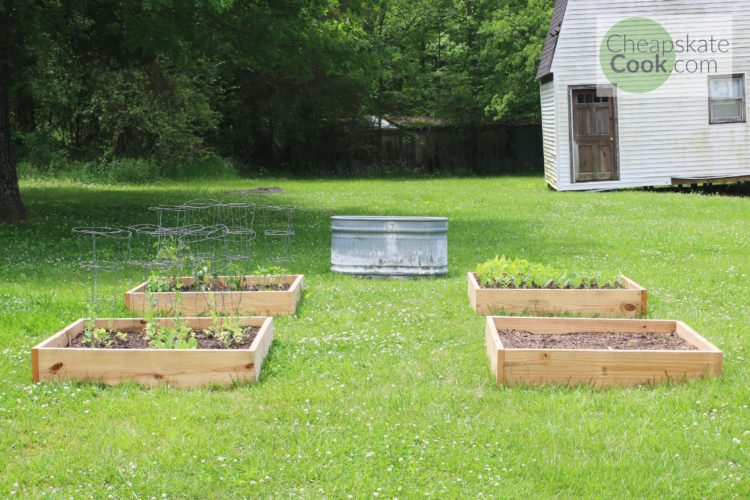
Tilled Garden
Our neighbor offered to till a plot in the yard for free, so we thanked him with some homemade bread and committed to one 22×24-ft in-ground garden for part of our space. This is our largest garden space by far, but we have 2 more garden areas we are caring for this year, and I’ll tell you why.
Raised Bed Garden
I don’t want to weed more than necessary, so I went ahead and built 4 raised bed gardens. This is the gardening method I am most familiar with and comfortable maintaining. Raised bed gardens are a bit of a financial commitment at the beginning (especially considering lumber prices right now) but I’ve grown square foot gardens on a budget for years, so I knew we could make it work.
Stock Tank & Deck Garden
Next, we used a few other things we had lying around. An old stock tank will house our potato plants, and a vertical garden someone gifted us with last year will sit on our back deck. I have some old pots from my parents’ house that hold our herbs on the deck.
How to Improve Your Garden on a Budget
The way you improve your garden on a budget is: slowly.
Every area of the world is different. What my soil in rural Tennessee needs is very different from what you need across the country in Nevada, or in Canada, or Australia. Every year that you garden, you get to know your area, the plants, the pests, and your particular garden better and better. Every year, you’ll learn more about what you specifically need to do to help your garden grow.
Read below to see how I prepped each garden area this year.
Hot Garden Tip:
Plant marigolds and lavender in your vegetable garden! They help keep pests away.
In-Ground Garden
After talking to my neighbor about his garden, I mixed a 2.5-pound bag of lime and a few cubic feet of cheap compost from the garden center into my in-ground garden. Over the years, I can build up the soil and make it richer, but this is what will work for the first year.
Raised Bed Garden
In my 4 raised bed gardens, I filled each box about halfway with raised garden bed mix (whatever I could find that was cheapest – which conveniently happened to be organic). Then I supplemented it with a few cheap bags of topsoil and compost.
The great thing about rasied bed gardens is that in the future, all I need to do is mix a handful of compost into each square foot before I replant that square. No soil tests or adding individual ingredients. Just a scoop of compost.
Hopefully, if my compost plans succeed, that will be free next year.
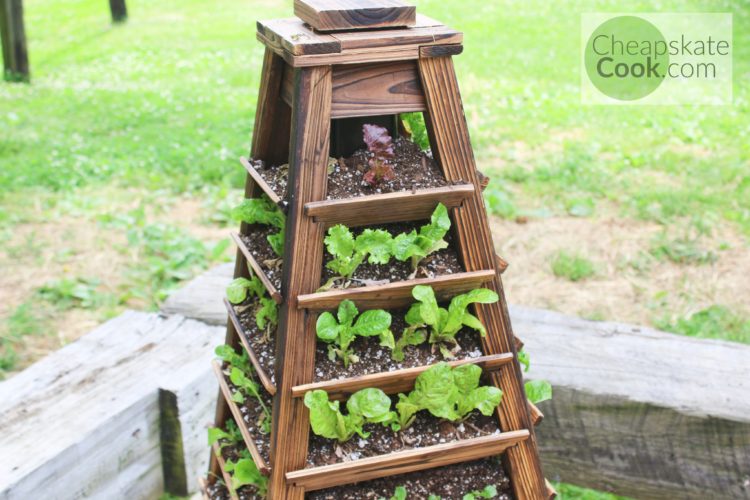
Another Hot Garden Tip:
When shopping for dirt at the garden center, go to the back of the store, That’s where they keep the cheaper stuff, and it works great!
Plus, if you find ripped bags (and are willing to spill a little dirt into the back of your vehicle), some stores will mark them down to 50% off. It doesn’t hurt to ask!
Stock Tank & Deck Garden
The stock tank will hold our potatoes, so I only filled it about 1/3 of the way with garden dirt. As the potatoes grow, I plan to keep filling it with dirt, leaving just the top leaves of the potato plants. This method is supposed to encourage a large harvest, because a larger portion of the plant becomes roots, which form potatoes. We’ll see if this works.
Can You Grow Your Own Food in Your Backyard?
Honestly, you can grow your own food anywhere. I started by growing my own food in a mason jar right in my kitchen.
In the past, our garden has never replaced our need for the grocery store. However, it’s given us plenty of fresh fruits and vegetables in seasons where those were precious.
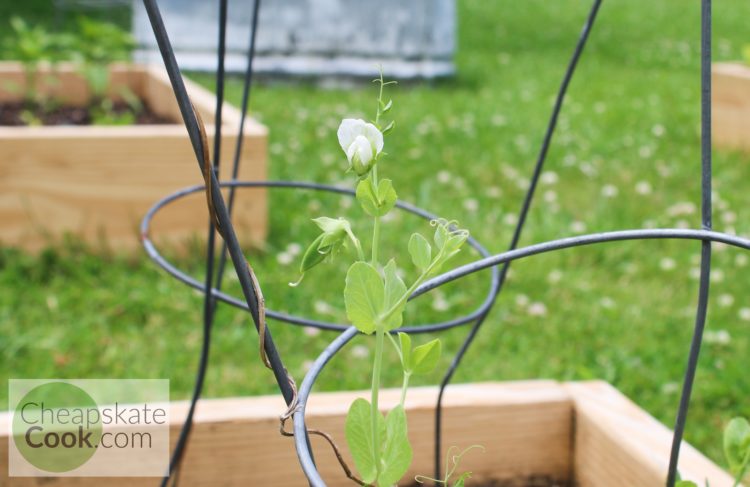
This year, here’s what I’m planting.
Earth Tower Garden:
- Lettuce
- thyme
- chives
- parsley
- lavendar
- chammomile
In Pots on the Deck:
- lemon balm
- mint
- Oregano
In-Ground Garden:
- Zucchini
- Pumpkin
- Cantaloupe
- Watermelon
- Sunflowers
- nasturtiums
- marigolds (helps keep pests away)
- zinnias
- Okra
Raised Bed Gardens:
- Potatoes (in the stock tank)
- green beans
- tomatoes
- sweet peppers
- jalapeños
- cilantro
- snap peas
- chard
- cut flowers
- marigolds
How to do My Garden on a Budget
How can I grow my own food?
Finally, in an effort to save as much money as possible, I started plants from seed this year. For some of them, I bought a $5 seed tray from Dollar General. For others, I used a recycled seedling tray from flowers. Lastly, I used toilet paper tubes filled with dirt and lined up in an old plastic salad container. The seedlings stayed outside when it was warm, and they came inside when temperatures dropped at night. I saved hundreds of dollars over buying everything in plants. And I saved weeks of wasted sunlight if I had waited until after our last frost to plant.
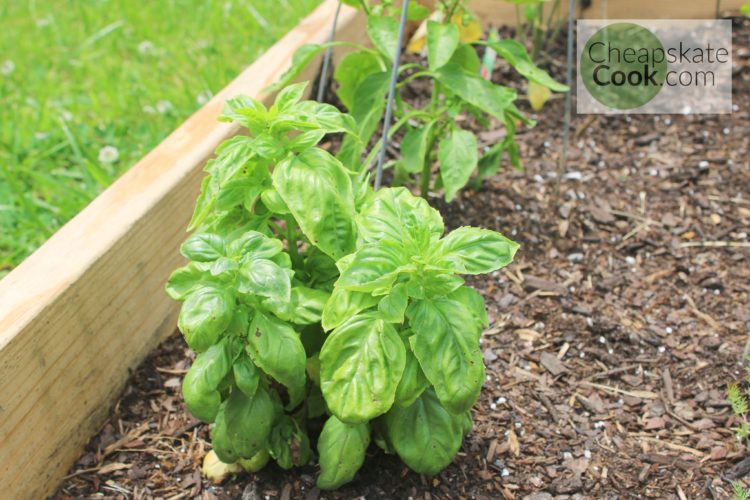
How Can I Make My Garden Look Nice Cheap?
Some our ideal gardens are paved with mulch and stone pavers. For now, I’m committed to keeping my garden looking tidy.
Here’s how I’ve learned to keep it nice:
– Weed regularly
– Mow the grass around it regularly. We made sure our boxes were far enough apart our mower could easily mow between them.
– Grow flowers with the vegetables. Not only does this help attract pollinators, but it makes your garden look really nice. Zinnias are easy to grow and look gorgeous.
– Ideally, I will lay down cardboard between the rows in my garden and place mulch and wood shavings on top. Currently, we have a giant pile of mulch someone gave us sitting next to our garden. It’s not enough to do the entire garden, and since I haven’t done it yet, I can’t say it will work. But it’s my plan!
Is Growing your own food worth it?
Is it cheaper to grow or buy vegetables? I’ve often wondered if growing my own fruits and vegetables actually saves me money.
Honestly, I don’t have a good answer.
Growing a garden takes more than just sticking some seeds in the ground, then picking tomatoes in July. Growing a garden takes money. If you’re not buying dirt, you’re buying weed cloth and mulch or wood chips to prevent weeds. You’re either buying plant starts in the spring or trays, seeds, and potting soil in the winter.
Then there’s all the work. You’re weeding and planning and bringing seedlings in from the frost, or covering them with sheets. You’re watering them every day (water costs money too). Your time is money too.
So I don’t say growing vegetables always helps me save money and eat healthy. Sometimes it does. Growing sprouts in my kitchen is way cheaper than buying them from the store. Swiss chard from the garden is an easy yes compared to organic greens for my smoothies. I’ve heard zucchini are plentiful, but last year, mine got eaten by bugs, so I never found out.
However.
Research says that eating fruits and vegetables grown locally is more nutritious than buying them from farms halfway across the country. It’s safer, benefits the environment, and has more nutrients.
Growing our own food doesn’t help us with the amount of produce we can eat on our budget, but it does help us with the quality of food on our budget.
There are other benefits to growing our own food, so I’ll quote what I wrote in this post about Why You Should NOT Plant a Garden:
“The act of connecting to the earth and growing food for my table is extremely relaxing and rewarding to me. It gets me outside when I could be scrolling Instagram.
My kids are not very enthusiastic about raw spinach unless it is connected to the actual plant, and they get to pull it off and eat it themselves. Same goes for almost everything (including kale raab) except cucumbers, tomatoes, and peppers – they still don’t care for those.
The first year we built our garden, it cost more than it saved. However, the only investment I have to make (and likely will make in the future) each year is a bag of compost. No tiller, no soil enhancers – I don’t even need a shovel. So theoretically, the garden will save more money every year until we move.
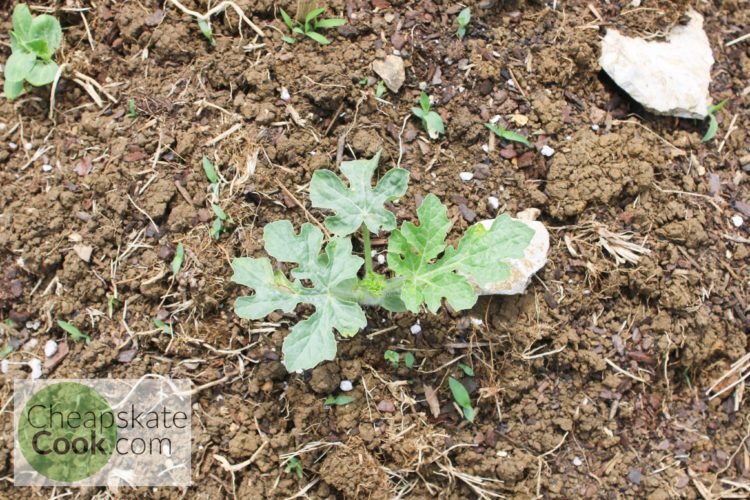
“Consider whether you are renting and will be moving soon. If you own your home, how many years do you plan on living here? These answers play an important and practical part of how much a garden will save you money long-term.
We live in a modern world, and for some of us, the cost and inconvenience of a backyard garden often outweigh the practical benefits and savings. That feels really wrong to say, but it has been true in my experience.
All that to say, I think backyard gardens are extremely important. If you have the room in your budget, a garden can be extremely beneficial to your health, well-being, the environment, your table, and eventually your budget.“
Backyard Garden on a Budget
Wherever you are in your backyard garden experience, I hope you try it. Grow some sprouts, buy a couple of pots, find an old pallet and fill it with dirt. It’s hard to beat the pride and joy that comes from going out to your garden in the morning with an empty basket and coming back with it overflowing.
A fresh tomato, still warm from the sun, is one of the tastiest things you’ll ever eat.
You can garden on a budget. I hope these ideas helped show you how.
What You Can Do Now:
Do you have a vegetable garden? How do you garden on a budget?
If you found this recipe helpful, let us know! Leave a comment, share it on Facebook or Pinterest, and follow us on Instagram or YouTube for more!
Slash your grocery budget and feed your family real food! Get simple, frugal, real food menu plans every month for FREE in the Cheapskate Cooks’ 1-Min Email. Get the next one here.

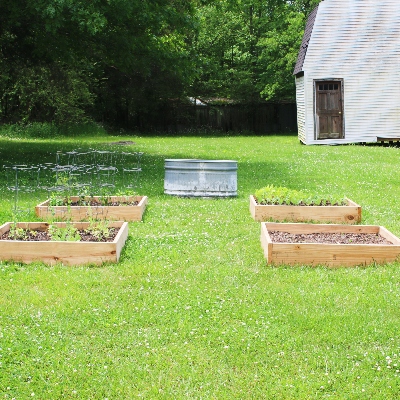
I’ve learnt the hard way to not import soil amendments. I’ve learnt to compost everything. What organic matter I can’t compost gets turned into weed tea. Fertiliser..
Thanks for the tips
Thanks for the tip!